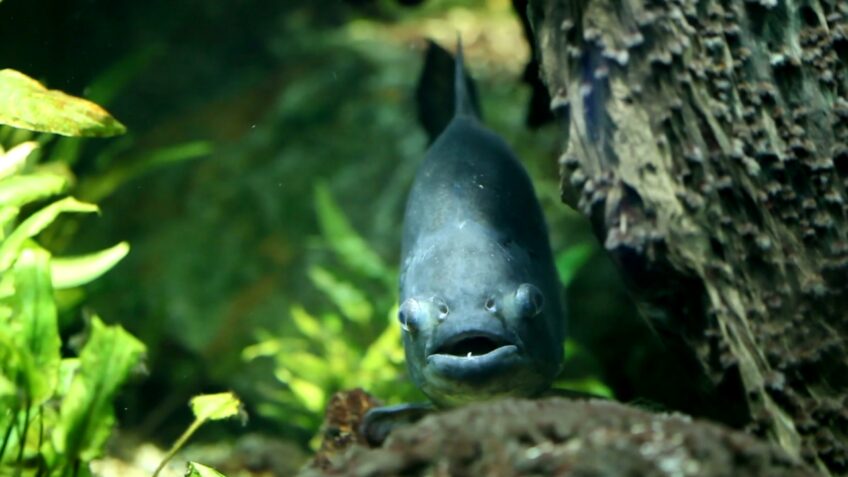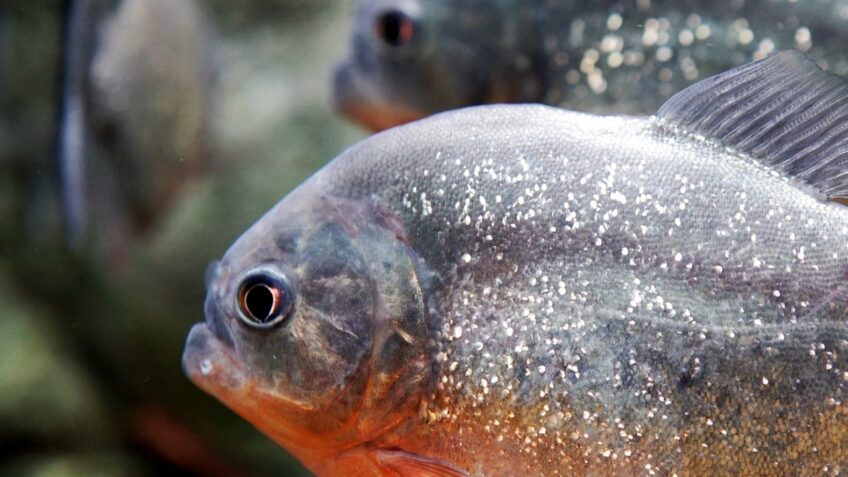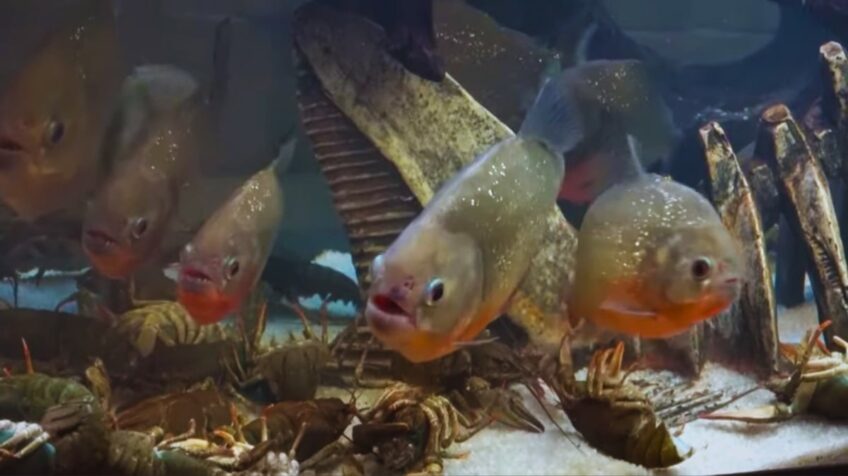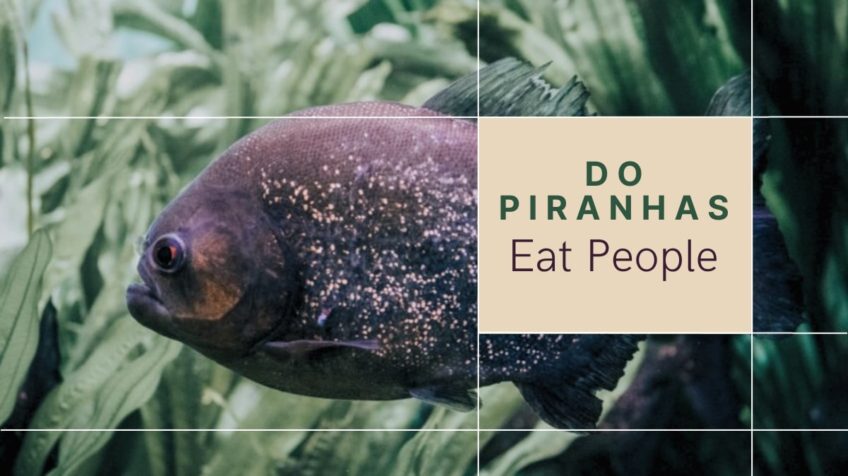Contrary to popular belief, piranhas do not have an innate desire to devour human flesh. While they are known for their sharp teeth and aggressive behavior, attacks on humans are relatively rare and often happen in self-defense or as part of a feeding frenzy. Here are some facts that debunk the myth of piranhas as man-eaters:
- They mostly feed on fish, insects, and plants, not on large mammals.
- There are over 60 different species of piranhas, and only a few of them are known to attack humans.
- They may bite humans who enter their territory or disturb them, but they rarely kill or eat people.
- In fact, there are many recorded cases of people swimming safely alongside them without incident.
The Truth About Piranhas

The myths and legends about Piranhas have been around for centuries. The notion that these fish are known for their man-eating habits is one of the more popular tales. But, is this true? Let’s take a look at what they do and don’t eat, and debunk some of these longstanding myths.
Where do Piranhas live?
Contrary to popular belief and media hype, piranhas are not man-eating predators. They are, in fact, omnivorous fish that inhabit the freshwaters of South America. They are typically found in rivers, lakes, and shallow streams throughout the Amazon Basin, the Orinoco Basin, and other river systems in Brazil, Bolivia, Colombia, Peru, and Venezuela. They prefer warm and slow-moving water, but can also adapt to colder and faster currents when necessary.
While they are known for their sharp teeth and aggressive behavior, they rarely attack humans unless provoked or threatened. It is important to note that while they are not man-eaters, they can still be dangerous to humans. Swimmers and divers are advised to avoid areas where they are present and to take precautions such as wearing protective gear and not wading in water if there are open wounds or bleeding.
How do Piranhas survive in the wild?
They are omnivores that primarily feed on fish, insects, and occasionally larger prey. They have a unique set of adaptations that allow them to survive in their natural habitats, including sharp teeth for tearing the prey, excellent eyesight to detect movement in murky water, and the ability to smell blood from miles away. Despite the popular myth that piranhas are man-eaters, there is no conclusive evidence that they have ever killed a human. Piranhas are typically wary of humans and will only attack when threatened or in rare situations where they mistake a shiny object or splashing as prey. In reality, they play a crucial role in maintaining a healthy ecosystem and are an essential part of their habitat’s food chain.
Different types of Piranhas and their preferred food
Contrary to popular belief, they are not aggressive man-eating fish. They are actually omnivores, feeding on a variety of prey including insects, fruits, crustaceans, and small fish. Here are the different types of Piranhas and their preferred food:
| Type of Piranha | Preferred Food |
| Red-Bellied Piranhas | Insects, worms, and crustaceans. They are also known to feed on small fish, but it’s not their preferred food. |
| Black Piranhas | These are known for their powerful jaws and teeth, which allow them to feed on larger prey such as frogs, snakes, and small rodents. |
| Pacu | Although closely related to Piranhas, Pacus are vegetarians and prefer to feed on fruits, nuts, and other plant-based food. |
Do not be misled by the rumors of Piranhas eating people. In reality, they are more interested in their natural diet of small prey, rather than attacking humans.
Debunking the Myths

The truth is that piranhas rarely ever attack humans and their feeding behavior is often misunderstood. In this article, let’s debunk the myths about piranhas eating people and look at what they really like to munch on.
Famous myths
One of the most common myths about piranhas is that they are ferocious man-eaters that will attack anything that enters the water. However, this couldn’t be further from the truth. Here are some famous piranha myths debunked:
| Myth # | Myth | Fact |
| 1 | Piranha can strip a human body of flesh in seconds. | While they do have sharp teeth and powerful jaws, they are typically scavengers that feed on smaller fish, insects, and plants. They rarely attack bigger prey and will usually only do so in self-defense or when they are starving. |
| 2 | Piranhas are bloodthirsty killers that will attack anything that moves. | They are actually shy and skittish creatures that prefer to stay hidden in the water. They are unlikely to attack humans unless they feel threatened or provoked. |
| 3 | Swimming in a river infested with piranhas is certain death. | Most of their species are found in freshwater rivers and lakes in South America. While it’s always wise to exercise caution when swimming in unfamiliar waters, the vast majority of piranhas are harmless to humans. |
Scientific evidence debunking Piranhas’ human attacks
Contrary to popular belief, piranhas are not a threat to humans and there is scientific evidence to support that they rarely attack people. While they are known for their sharp teeth and fish-like appearance, they are primarily omnivores and scavengers, feeding on insects, fish, and other aquatic animals. The myth of their man-eating habits can be traced back to Hollywood films and mainstream media that portrayed them as vicious predators.
However, studies have shown that piranha attacks on humans are rare and usually occur in situations where the water is murky or the fish are stressed or hungry. Furthermore, they tend to be skittish around humans and will usually flee rather than attack when they encounter them in the wild.
Risk of Piranhas attack
They do not view humans as a source of food and are not attracted to the scent of blood, contrary to popular media portrayals. They are usually shy and tend to avoid larger animals, including humans. Even when provoked, piranhas are less likely to attack humans and more likely to flee from danger. It is important to recognize that most piranha attacks on humans occur when the water levels are low, and they are threatened by a lack of food or overcrowding.
Piranhas Attacks vs. Other Freshwater Fish Attacks
While the public perception of piranhas is that they are wild, ferocious creatures with an appetite for human flesh, the reality is far from the truth. They are no more likely to attack humans than other freshwater fish, such as bass and catfish, even though their sharp teeth are certainly capable of inflicting painful bites. In this section, we will compare and contrast the attacks of piranhas and other freshwater fish to give you a better understanding of the risk posed by both.
Some freshwater fish attack humans
While piranhas do occasionally attack humans, their attacks are often over-exaggerated for entertainment purposes in movies and TV shows. In reality, there are other freshwater fish species that are more aggressive toward humans. For example, the arapaima, a large fish found in the Amazon River basin, has a reputation for attacking humans if provoked or disturbed. Another fish, the electric eel, can deliver a powerful electric shock that can cause injury or even death. However, it’s important to note that these attacks are rare and often only occur when humans enter the fish’s natural habitat and provoke them. In general, freshwater fish pose little threat to humans and can be safely enjoyed for recreational purposes.
How to avoid/fight a freshwater fish attack
Freshwater fish attacks are rare occurrences that can be avoided with proper precautions, knowledge, and equipment. Piranha attacks, in particular, have been exaggerated and misunderstood due to movies and media. Here are some tips to avoid or fight a freshwater fish attack:
| 1. Check the local regulations before swimming or fishing in freshwater. |
| 2. Avoid swimming or fishing in murky or shallow waters, which increases the risk of encounters with fish. |
| 3. Avoid wearing shiny or bright clothing while swimming or fishing, as this can attract fish. |
| 4. If you encounter a fish, such as a piranha or an alligator gar, do not panic or make sudden movements. Slowly swim or back away from the fish. |
| 5. In the case of a piranha attack, try to move to the shore or into shallow water. They are less aggressive in shallow water and will likely retreat. |
| 6. In the case of other freshwater fish attacks, such as catfish or bass, use protective gloves and equipment to handle the fish. |
Importance of Piranhas in the Ecosystem
They are an important part of their ecosystem and play a crucial role in maintaining the balance of the aquatic environment despite the common myths of their man-eating habits. Here are some ways that Piranhas contribute to their ecosystem:
- They help to control the population of other fish species, which helps in keeping the food web balanced.
- They are scavengers and feed on the dead carcasses of animals, cleaning up the aquatic environment.
- Piranhas help to prevent the spread of parasites and diseases in their habitats, maintaining the health of the ecosystem.
It is important to understand the valuable role Piranhas play in their environment and avoid the false narratives portrayed by media and entertainment.
Other animals that rely on Piranhas
Some animals that rely on them include giant otters, caimans, and birds of prey. These animals are well adapted to hunt and feed on piranhas without getting hurt themselves. While they can be dangerous to people if they feel threatened, they generally feed on smaller fish and aquatic animals. In their ecosystem, they help to control these populations and maintain a healthy balance in the food chain. It is important to understand and respect the role that piranhas play in their ecosystem, rather than fearing them based on misconceptions and myths.
FAQs

Can piranhas live in aquariums?
Yes, many species are popular aquarium fish. However, it is important to note that they can be aggressive towards each other and other fish, and require a large aquarium with appropriate filtration and hiding places.
How long do piranhas live?
The lifespan varies depending on the species, but they generally live for 5 to 10 years in the wild and up to 20 years in captivity.
Are piranhas endangered?
Several species are considered endangered due to overfishing and habitat destruction.
Do piranhas have any predators?
They are preyed upon by a variety of animals, including caimans, birds of prey, and larger fish such as catfish and arapaima.
How fast can piranhas swim?
They are fast swimmers and can reach speeds of up to 15 miles per hour.
Are all piranhas aggressive?
While they are known for their sharp teeth and aggressive behavior toward each other and other animals, they are not usually aggressive toward humans and will only attack if they feel threatened or provoked.
Can piranhas be kept as pets?
Yes, many species are kept as pets, but it is important to research the specific needs of the species and provide appropriate care and housing.
Do piranhas travel to schools?
Yes, they are social animals that live in schools, which can range in size from a few individuals to hundreds of fish.
Where can piranhas be found?
They are native to the rivers and streams of South America, where they are found in a wide range of habitats, from slow-moving backwaters to fast-flowing rapids.
Can piranhas survive in saltwater?
No, they are freshwater fish and cannot survive in saltwater.
Conclusion
In conclusion, the myth of piranhas as man-eaters is just that – a myth. Despite their fearsome reputation and sharp teeth, piranhas are not interested in attacking humans and there is no documented evidence of piranhas killing people. This misconception has been perpetuated by Hollywood movies and sensationalist media reports, leading to fear and misunderstanding of these fascinating creatures. By understanding the true nature of piranhas and their feeding habits, we can help to dispel the fear and protect them and their habitat. While swimming in piranha-infested waters does carry some risk, by taking appropriate precautions, we can safely observe and appreciate these unique and important members of the freshwater ecosystem.

